

We surveyed more than 600 economists worldwide on their views about the central bank inflation target and other related monetary policy issues. Most respondents prefer their central bank to have an explicit inflation target, and roughly half want the central bank to keep its current target. Conditional on supporting a change, the preference is two to one in favor of raising the current target. Respondents who are worried about the central bank credibility are less likely to support a target raise. Conversely, preference for a target raise is more likely to come from those who are concerned about the effective lower bound on monetary policy rates. Only a quarter of the respondents would increase the inflation target following a permanent decline of the equilibrium real interest rate. Most respondents prefer the central bank to have also other objectives than just price stability.
A key question for any inflation targeting framework is what the inflation target should be. Theoretical and practical considerations made central banks in advanced economies converge to a 2% inflation rate target (and often higher targets in emerging economies). However, consequences of the Global Financial Crisis, with years of “low-flation” and the effective lower bound (ELB) constraining central bank policy rates, have challenged the consensus. One proposal to limit the repeated occurrence of effective lower bound episodes in the future is to raise the central bank inflation target (see Blanchard et al., 2010; Ball, 2013; Krugman, 2014). However, a higher inflation target also carries costs associated with more volatile and higher average inflation (Bernanke, 2010). Review of the Federal Reserve Bank and the ECB monetary policy strategy framework further stimulated the debate.1
In our recent paper (Ambrocio et al. 2022), we contribute to this debate with an expert survey on the inflation target and related monetary policy issues, run at the end of 2020.2 More than 600 economists worldwide responded, based on a sample comprising all top 10% researchers according to RePEc, as well as the CEPR and NBER research fellows in the fields most closely related to the issues discussed in the paper. Most participants came from the US (39%) and the euro area (26%). An appendix provides a breakdown of the respondents’ background characteristics in more detail.
Our four main findings are:
1. Most respondents prefer central bank to have other objectives than just price stability.
2. Supporters of inflation targeting express a significant preference for maintaining the current numerical target. Conditional on supporting a change, however, the preference is two to one in favor of raising the current target.
3. The main reason to keep the current target appears to be concern for the central bank credibility while the main reason to raise the target is the concern for the ELB.
4. Only 25% of respondents would increase the inflation target following a permanent decline of the equilibrium real interest rate (r*).
In what follows, we discuss these findings more in detail in light of the recent monetary policy debate.
Following the high inflation experience of the 1970s, the focus of monetary policy increasingly shifted towards price stability (Meltzer, 2009). The inflation targeting framework that many central banks have adopted since then represents the culmination of this process. However, following the 2008 crisis, an episode with relatively stable prices but a high degree of financial turmoil and large unemployment fluctuations, several critics have questioned the right balance between price stability and the other objectives of monetary policy (DeGrauwe, 2008; Leijonhufvud, 2008).
Against this backdrop, we asked participants about their views on the monetary policy mandate. Only about 14% of the respondents support a sole price stability objective (see Figure 1). Most prefer the central bank to have also other objectives, either with equal weights with price stability (48%), or subordinate to price stability (38%). Respondents from the euro area and from the US expressed marked differences in their views. In line with the mandates of the respective central banks at the time of the survey, the Fed-style “dual mandate” gets significantly more support from US respondents. Conversely, euro area respondents are evenly split between supporting the ECB’s “subordinate mandate” and a dual mandate. In written responses, the most popular other objective is (un)employment, although only slightly more than 40% of the respondents would make a target for the secondary objective explicit, like for the inflation rate.
Figure 1: What should the central bank’s objective(s) be?
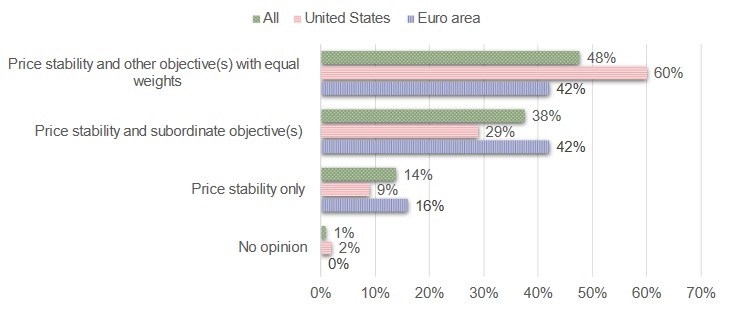
Potential alternatives—such as the price level, the level of nominal GDP or its growth rate—only received minor support. We did not explicitly ask about average inflation targeting, which the Fed adopted in its 2020 strategy review. Interestingly, however, among the various formulations of the preferred target, written responses mentioned a range for the inflation rate much more often than average inflation.
In a subsequent question regarding the specific price index that the central bank should use, we find almost the same support for headline and core CPI (27 vs. 25%) as the price index to target. However, a much stronger preference for the core index (CPI = 27%, PCE = 33%) emerged in the US sub-sample.
The key question of the survey combined two parts. The first asked whether the central bank should have an explicit inflation target. In case of a positive answer, participants could specify a numerical value. Almost 80% of the respondents want their central bank to have an inflation target.3 To make answers concerning the preferred numerical inflation target comparable across countries, we define
PREFERRED CHANGE OF INDIVIDUAL i
=
PREFERRED INFLATION TARGET OF INDIVIDUAL i – ACTUAL INFLATION TARGET OF COUNTRY WHERE i RESIDES
Figure 2: Preferred change in the inflation target
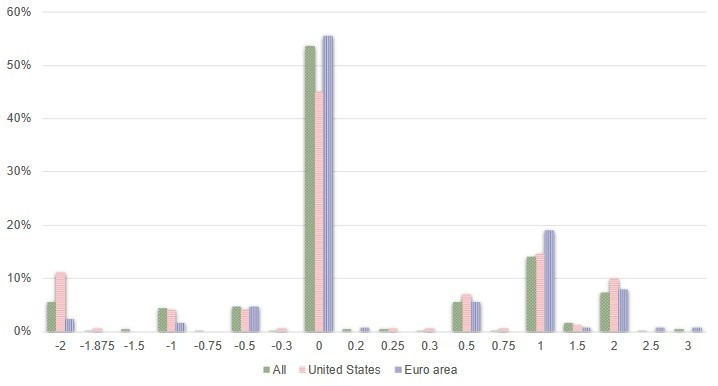
Among respondents from inflation targeting countries or regions, more than half (54%) support the central bank’s current target, about 30% would prefer a higher target, while 16% would choose a lower target (see Figure 2). The median preferred deviation from the current target is one percentage point in either direction. In the US subsample a discernible minority prefers zero inflation.4
The cost of changing the target
Among the potential costs of changing the inflation target, the credibility of the central bank is a chief concern. A change of the target may unmoor inflation expectations, especially if the private sector starts believing that further changes may occur again in the future.
We investigate indirectly to which extent such costs influence the respondents’ views by positing a hypothetical scenario in which the central bank had previously not adopted an inflation target but at some point decides to adopt one. In this scenario, we ask about the preferred inflation target, given the current longer-term, structural economic trends. Fewer respondents (about 12 percentage points fewer) prefer no change in this hypothetical scenario than in current conditions. Most of those who change their view prefer to increase the target in the hypothetical scenario so that the share of “target maintainers” and “target increasers” becomes almost the same. We infer a considerable latent backing for a target change, and in particular for an increase. Our conjecture is that the loss of credibility is the main cost of changing target in current conditions. Subsequent questions in the survey corroborate this hypothesis.5
The determinants of the optimal inflation target
Schmitt-Grohé and Uribe (2010) have recently surveyed the academic literature on the optimal rate of inflation, which dates back at least to Friedman (1969). Presenting a list of factors based on this literature, we asked respondents to “rank” (as well as complement the list of) the factors determining the inflation target in terms of importance, using a five-grade scale from “unimportant” to “of the utmost importance”.
All listed factors obtain an average score between “moderately important” and “quite important”, falling within the numerical range between 3 and 4 (see Table 1). We also considered the average scores by subsamples, split by preference for either keeping, decreasing, or increasing the current target. The zero-lower bound on monetary policy rates is a significantly more important factor for supporters of a target increase than for supporters of no change.6 We interpret this finding to mean that the supporters of a target increase are more concerned about the effects of the zero-lower bound on the conduct of monetary policy.
Table 1: Factors determining the inflation target (inflation target change split)
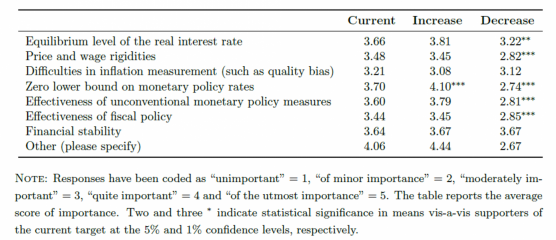
The debate on the secular decline of r* (Summers 2014), which is tightly related to the frequency of the ELB episodes, has been one of the main driving factors behind the renewed interest in the optimal choice of the inflation target (Kiley and Roberts, 2017).7 With this debate in mind, we asked respondents for their views on r*. Their average estimate of r* in the full sample is 0.6% (see Table 2). The mean and the median are consistent across sub-samples. However, we find that views on r* do not predict a preference for increasing the inflation target, not even among respondents who believe in a negative relationship between r* and the optimal inflation rate (see Andrade et al. 2019). The very wide range of views, depicted in Table 2, may be a possible reason for the weak relationship.
We find that 25% of the survey participants would like to increase the inflation target in response to a hypothetical one percentage point permanent decline in r*. However, 34% of survey participants would leave the target unchanged in such a scenario, while 16% would actually decrease the target and a considerable share (25%) has no opinion. This result provides further evidence that many experts envision significant costs of changing the inflation target (see the earlier discussion in section 3).
Table 2: Views on r*
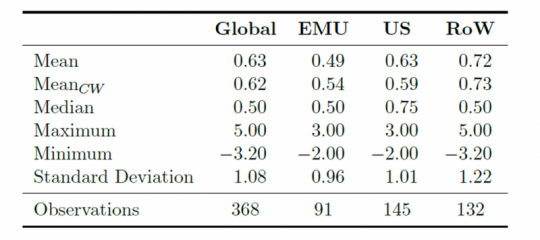
Our survey asked leading economists from around the world about their views on three key areas: the inflation target, the central bank’s broader objectives, and the relationship between the equilibrium real interest rate and the optimal inflation target. Overall, we find a strong preference for the status quo. Participants seem to perceive high costs in terms of credibility costs from changing the current inflation target. While the recent high-inflation environment may put the debate on changing the inflation target aside, our results should remain nonetheless useful to think about the trade-offs associated with changing inflation target in the future.
Appendix: Respondents’ background information
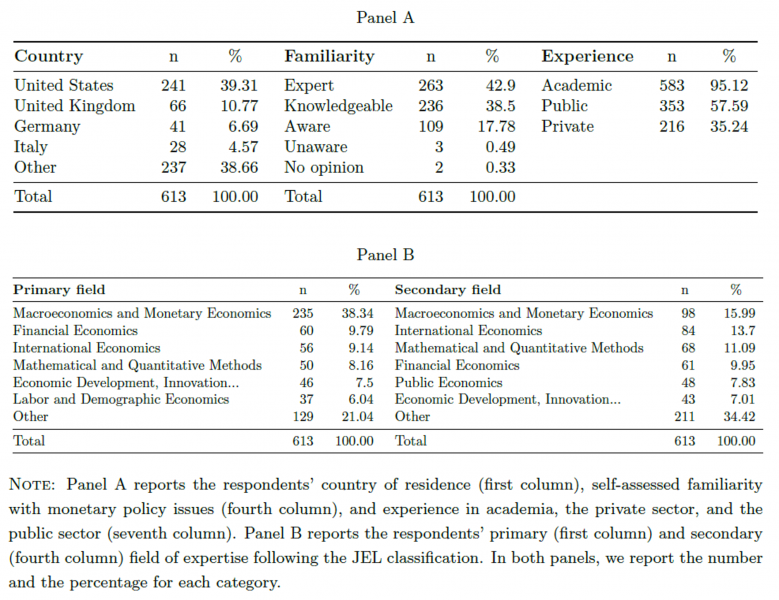
Ambrocio, G., Ferrero, A., Jokivuolle, E., & Ristolainen, K. (2022). What should the inflation target be? Views from 600 economists. CEPR Discussion Paper 17289 and Bank of Finland Research Discussion Paper 7/2022.
Andrade, P., J. Galí, H. Le Bihan, and J. Matheron (2019). The optimal inflation target and the natural rate of interest. Brookings Papers on Economic Activity Fall 2019, 173-249.
Ball, L. (2013). The case for 4% inflation. Central Bank Review 13, 17-31.
Bernanke, B. (2010). The economic outlook and monetary policy. In Speech at the Jackson Hole Economic Policy Symposium.
Blanchard, O., G. Dell’Ariccia, and P. Mauro (2010). Rethinking macroeconomic policy. Staff Position Note 10/03, IMF.
Blinder, A. (2000). Central-Bank Credibility: Why do we care? How do we build It? American Economic Review 90, 1421-1431.
DeGrauwe, P. (2008). There is more to central banking than inflation targeting. VoxEU, 14 November.
Friedman, M. (1969). The Optimum Quantity of Money. Mcmillan.
Ehrmann, M., S. Holton, D. Kedan, and G. Phelan (2021). Monetary policy communication: Perspectives from former policy makers at the ECB. Working Paper 2627, ECB.
Kiley, M. and J. Roberts (2017). Monetary policy in a low interest rate world. Brookings Papers on Economic Activity Spring 2017, 317-372.
Krugman, P. (2014). Inflation targets reconsidered. Unpublished.
Leijonhufvud, A. (2008). Central banking doctrine in light of the crisis. VoxEU, 13 May.
Meltzer, A. (2009). A history of the Federal Reserve, Volume 2, Book 2, 1970-1986. University of Chicago Press.
Schmitt-Grohé, S. and M. Uribe (2010). The optimal rate of inflation. In B. Friedman and M. Woodford (Eds.), Handbook of Monetary Economics, Volume 3, Chapter 13, pp. 653-722. Elsevier.
Summers, L. (2014). Reflections on the `New secular stagnation hypothesis’. In C. Teulings and R. Baldwin (Eds.), Secular Stagnation: Facts, Causes and Cures, Chapter 1, pp. 27-38. CEPR Press.
In line with the view of increasing the target, the ECB slightly raised its inflation target in July 2021 from “close but below 2%” to 2%. Despite keeping the target unchanged at 2%, the Fed adopted an average inflation targeting framework, which requires to “make up” periods of below-target inflation with periods of inflation above target (and vice versa). See https://www.ecb.europa.eu/home/search/review/html/index.en.html and https://www.federalreserve.gov/newsevents/pressreleases/monetary20200827a.htm, respectively.
Our approach is related to the one taken by Blinder (2000).
Almost all survey participants (96%) reside in countries with inflation targeting central banks.
A few of these respondents explicitly refer to the Friedman rule (Friedman 1969) in written comments.
The important role of central bank credibility also emerges from the results in Ehrmann et al. (2021), who surveyed former ECB Governing Council members focusing on monetary policy communication.
Note that we interchangeably also use the concept of zero lower bound and effective lower bound.
Notwithstanding the current bout of inflation, some observers have not fundamentally changed their views on the secular decline of r* (see, e.g., Olivier Blanchard’s interview with Martin Wolf in the Financial Times, 26 May 2022).